BW Star Schema
In Chapter 1, we introduced the concept of a star schema. In Chapter 2, Screen 2.31 showed an InfoCube data model. Armed with this information, the question then becomes:
What does the InfoCube data model look like at the database level?
In this section, we will explore the relationships between database tables. They will give us a clear idea of what the star schema looks like in BW. Again, we use a step-by-step procedure.
Work Instructions
Step 1. Run transaction SE11, enter /BIC/FIC_DEMOBC as the fact table name, and then click  .
.
Note
From Screen 4.3, we know that /BIC/FIC_DEMOBC is the name of the fact table.
If we are interested in only the table contents, and not the table definition, we can run transaction SE16 instead.
SCREEN 7.1
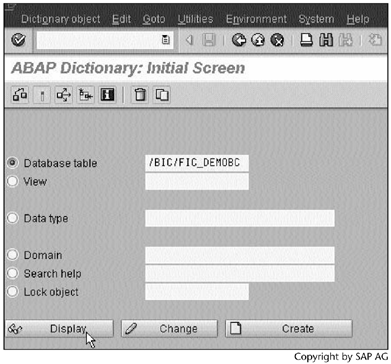
Step 2. The Check table column lists parent tables of the fact table. Double-click /BIC/DIC_DEMOBC3 to display the sales representative dimension table.
Note
BW uses D to name dimension tables.
- DP is for the data packet dimension. We will discuss its role in BW in Chapter 12.
- DT is for the time dimension.
- DU is for the unit dimension.
SCREEN 7.2
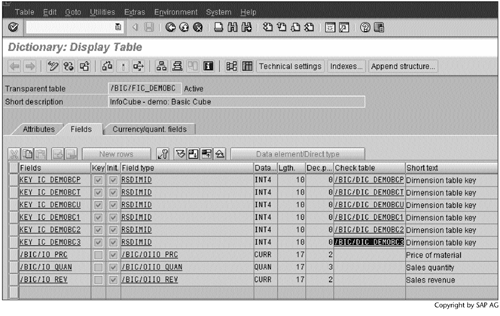
Step 3. The dimension table does not have any check tables, but it has a field called SID_IO_SREP. Click  to display the table's contents.
to display the table's contents.
SCREEN 7.3
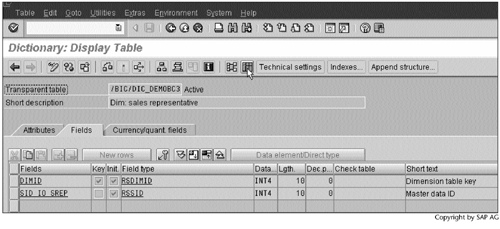
Step 4. Click  to execute.
to execute.
SCREEN 7.4

Step 5. Notice that SID_IO_SREP 11 corresponds to DIMID 23.
From Screen 4.4, we know that DIMID 23 is the value of the field KEY_IC_DEMOBC3 in the first row of the table /BIC/FIC_DEMOBC.
Then what does SID_IO_SREP 11 represent?
SCREEN 7.5
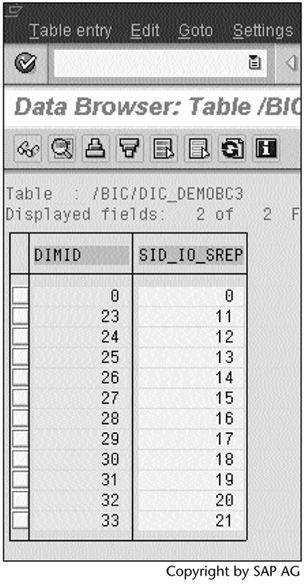
Step 6. Repeat Step 1 to display the contents of IO_SREP's SID table, /BIC/SIO_SREP. This screen shows the SID table definition. Click  to display the table's contents.
to display the table's contents.
SCREEN 7.6
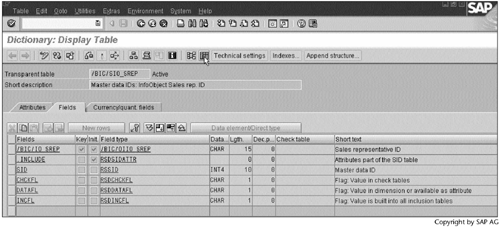
Note
Here SID is Surrogate-ID, not the System ID used to name an SAP system.BW uses S to name a characteristic's SID table.
Step 7. The contents of the SID table /BIC/SIO_SREP are displayed.
In this screen, we see that SID 11 corresponds to SREP01, a sales representative ID in the first record of Table 3.3.
SCREEN 7.7
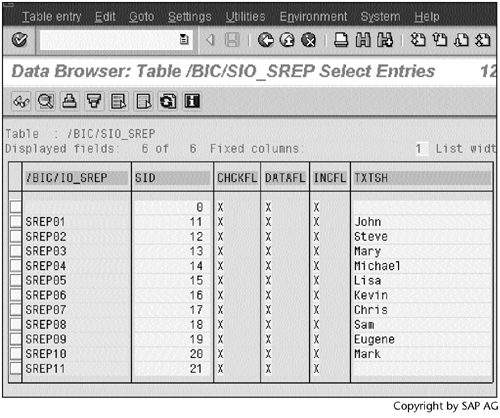
Following the same approach, we can discover the relationships between the SID table /BIC/SIO_SREP, the master data table /BIC/PIO_SREP, and the text table /BIC/TIO_SREP. The contents of the latter two tables are shown in Screens 7.8 and 7.9.
Step 8. Repeat Step 1 to display the contents of IO_SREP's master data table, /BIC/PIO_SREP. This screen shows the table's contents.
SCREEN 7.8
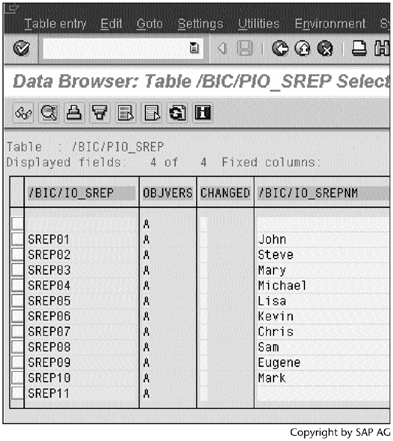
Step 9. Repeat Step 1 to display the contents of IO_SREP's text table, /BIC/TIO_SREP. Screen 7.9 shows the table's contents.
SCREEN 7.9
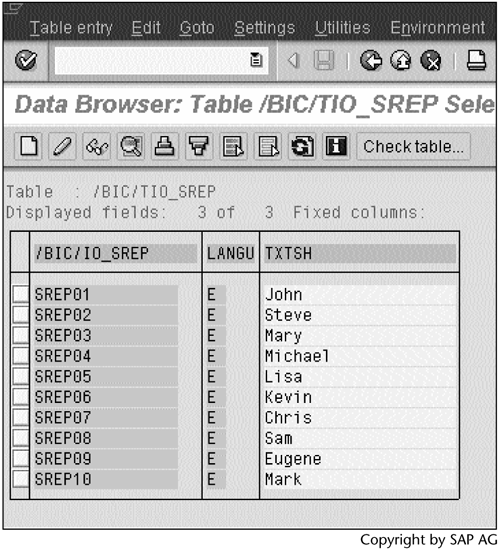
Step 10. Repeat Step 1 to display the contents of IO_SREP's hierarchy table, /BIC/HIO_SREP. Screen 7.10 shows the table's contents.
Note
Screen 7.10 shows the contents of the hierarchy table, /BIC/HIO_SREP. Unlike the master data table and the text table, the hierarchy table does not link to the SID table. BW builds the hierarchy based on the information in the tables /BIC/IIO_SREP, /BIC/KIO_SREP, and /BIC/SIO_SREP.
SCREEN 7.10
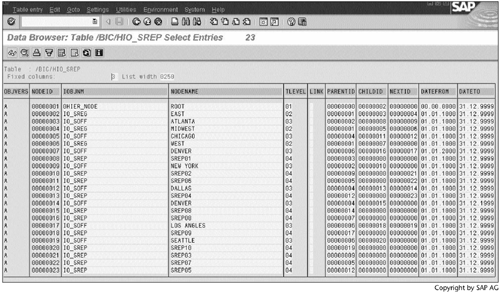
Result
Based on our discussion, we can draw a simplified star schema as shown in Figure 7.1.
Figure 7.1. BW STAR SCHEMA FOR PART I INFOCUBE DESIGN
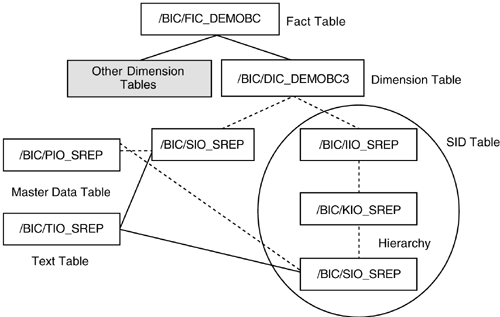
In Figure 7.1, the solid lines are the true masterdetail relationships, reinforced by foreign keys. The dashed lines are relationships that are maintained by ABAP programs, but not reinforced by foreign keys.
The dashed-line relationships allow us to load transaction data even when the database does not contain any master data. Screen 7.11 shows the InfoPackage used in Section 3.9. Under the Update parameters tab, notice the Always update data, even if no master data exists for the data option.
SCREEN 7.11

With this star schema in mind, let's look at three InfoCube design alternatives.
Part I. Guided Tours
Business Scenario and SAP BW
- Business Scenario and SAP BW
- Sales Analysis A Business Scenario
- Basic Concept of Data Warehousing
- BW An SAP Data Warehousing Solution
- Summary
Creating an InfoCube
- Creating an InfoCube
- Creating an InfoArea
- Creating InfoObject Catalogs
- Creating InfoObjects Characteristics
- Creating InfoObjects Key Figures
- Creating an InfoCube
- Summary
Loading Data into the InfoCube
- Loading Data into the InfoCube
- Creating a Source System
- Creating an Application Component
- Creating an InfoSource for Characteristic Data
- Creating InfoPackages to Load Characteristic Data
- Checking Loaded Characteristic Data
- Entering the Master Data, Text, and Hierarchy Manually
- Creating an InfoSource for Transaction Data
- Creating Update Rules for the InfoCube
- Create an InfoPackage to Load Transaction Data
- Summary
Checking Data Quality
- Checking Data Quality
- Checking InfoCube Contents
- Using BW Monitor
- Using the Persistent Staging Area (PSA)
- Summary
Creating Queries and Workbooks
- Creating Queries and Workbooks
- Creating a Query Using BEx Analyzer
- Organizing Workbooks Using BEx Browser
- Using a Variable to Access a Hierarchy Node Directly
- Summary
Managing User Authorization
- Managing User Authorization
- Creating an Authorization Profile Using Profile Generator
- Creating an Authorization Object to Control User Access to the InfoCube Data
- Integrating Profile Generator and BEx Browser
- Summary
Part II. Advanced Topics
InfoCube Design
- InfoCube Design
- BW Star Schema
- InfoCube Design Alternative I Time-Dependent Navigational Attributes
- InfoCube Design Alternative II-Dimension Characteristics
- InfoCube Design Alternative III Time-Dependent Entire Hierarchies
- Other InfoCube Design Techniques
- Summary
Aggregates and Multi-Cubes
Operational Data Store (ODS)
- Operational Data Store (ODS)
- Creating an ODS Object
- Preparing to Load Data into the ODS Object, Then into an InfoCube
- Loading Data into the ODS Object
- Loading Data into the InfoCube
- Using 0RECORDMODE for Delta Load
- Summary
Business Content
- Business Content
- Creating an R/3 Source System
- Transferring R/3 Global Settings
- Replicating R/3 DataSources
- Installing Business Content Objects and Loading R/3 Data
- Summary
Generic R/3 Data Extraction
- Generic R/3 Data Extraction
- Creating Views in R/3
- Creating DataSources in R/3 and Replicating Them to BW
- Creating a Characteristic in BW
- Loading Data from R/3 into BW
- Summary
Data Maintenance
Performance Tuning
- Performance Tuning
- BW Statistics
- System Administration Assistant
- Tuning Query Performance
- Tuning Load Performance
- Summary
Object Transport
Appendix A. BW Implementation Methodology
Object Transport
Appendix B. SAP Basis Overview
Object Transport
- Object Transport
- Section B.1. SAP Basis 3-Tier Architecture
- Section B.2. Dispatcher, Work Processes, and Services
- Section B.3. Memory Management
Appendix C. Glossary
Appendix D. Bibliography
EAN: N/A
Pages: 106
